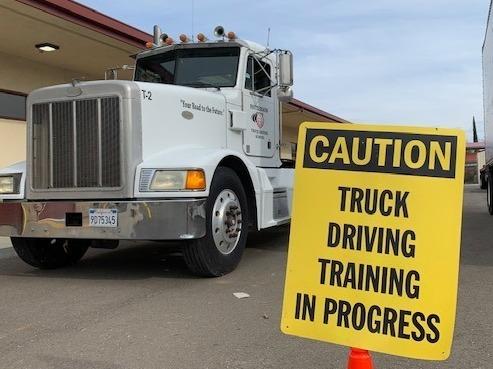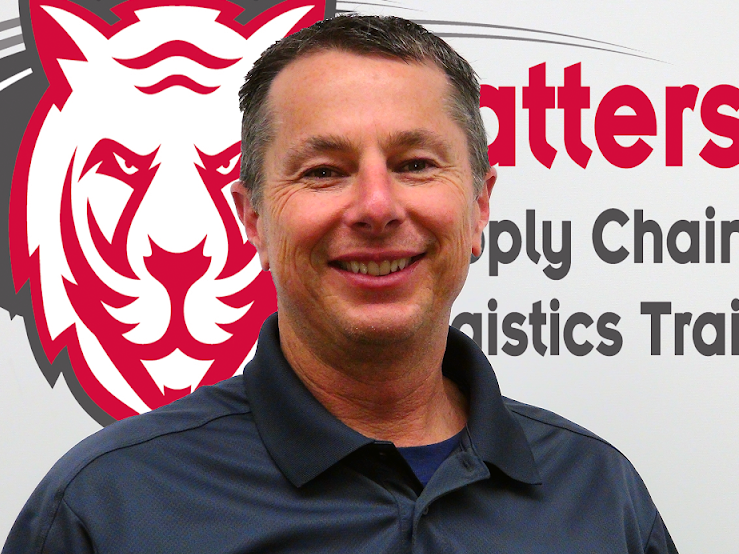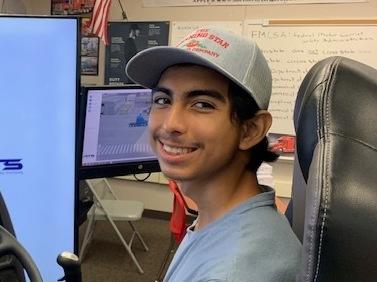Section Branding
Header Content
High schoolers are training to drive 18-wheelers amid a shortage of truck drivers
Primary Content
When thinking about the trucking industry, the first thing that comes to mind about its drivers is that they tend to be older — industry experts say the average trucker is 54 years old. But given the nationwide truck driver shortage, that's now changing.
A high school in California is now training teens to enter the industry through its truck driving school program.
Patterson High School in Patterson, Calif., is one of the first non-vocational high schools in the country to offer a truck-driving program for students.
The elective course, which is open to seniors, is a part of the school's Career Technical Education Program — helping students learn workplace skills through hands-on training.
"A lot of [students] who enroll in the course have never considered trucking as a career," instructor Dave Dein told NPR. "Trucking doesn't have a great reputation and it comes with a lot of misconceptions about what exactly a truck driver is."
Those misconceptions include that the work is dangerous, comes with low pay and and that the hours are unbearable.
"If we don't start promoting trucking to our youth, they only can make decisions on the information that they have," Dein said.
Guiding students through the basics of the trucking industry and trucking safety, Dein teaches not only the regulations to get a commercial driver's license, but also real-world scenarios that truckers face while on the road.
Dein, who has been in the trucking industry since 1988, says his career in trucking began as a way to support himself through college. But after earning his degree and working for a few years, he says he was "called to teaching."
"... but I never left trucking," he said. "I would always either drive on the weekends or part-time not because I had to, but because I enjoyed it."
The industry is suffering from a shortage of workers
As the supply chain continues to suffer due to the pandemic, a truck driver shortage factored into the mix is adding to supply and shipping delays.
And within the past decade, the trucking industry has constantly struggled with a driver shortage.
According to the American Trucking Associations, trucks move roughly 72.5% of the nation's freight by weight — carrying items such as oil, food, clothing, paper products and vehicles to name a few.
An ATA study found that in 2015, there was a need for 48,000 truck drivers.
As of 2021, the industry is short 68,000 drivers that are needed on the roads — as 25% of current truckers have reached retirement or are close to the age of retiring, according to Lindsey Trent of the Next Generation in Trucking Association.
Trent, who serves as co-founder and president of the nonprofit trucking association, says that if the shortage of truckers continues to grow, by the year 2028 the shortage could exceed 100,000 drivers.
But hiring teens to get behind the wheel of the big rigs could potentially solve this issue.
"We need good, safe drivers. Instead of [trucking] being a second or third career choice for people, we're trying to be the first choice and really attract talent in our industry at a younger age," Trent said.
Steve Viscelli, a sociologist at the University of Pennsylvania who studies the trucking industry, says adding young drivers won't solve the industry's biggest problem: retention.
"There is no reason to think we'd have any different outcome. We'd simply chew through another cohort of even younger drivers," he told NPR.
It's not a first-choice elective for most students
While hiring teenagers may help with the nationwide truck driver shortage, it's probably hard to actually imagine them driving an 18-wheeler.
In the program, students are undergoing 180 hours of classroom training along with 30 hours of lab sessions outside the classroom as they get first-hand experience in trucking. Those who want to pursue a trucking career must undergo further training once they're 18 years old. Currently, truckers must be at least 21 to haul goods across state lines.
For some students enrolled in the program, the thought of actually having their commercial driver's license right before graduation is something they didn't imagine would happen.
"It was not an elective I would've chosen because I didn't think that truck driving was for me," said Patterson High senior Eduardo Dominguez-Sotelo.
But after scoring high on a job assessment test during his junior year, Dominguez-Sotelo says Dein contacted him and suggested he enroll in the course.
"In the end, it actually ended up being a good fit for me," Dominguez-Sotelo said.
After graduation in 2022, he says he is interested in pursuing a career in computer engineering, hoping to make use of his commercial driver's license to go into trucking part time. Dein says he wants all his students to consider trucking as part of their career.
"I hope [the students] will come away with an appreciation for what truck drivers do, seeing the bigger picture and how they can fit in the industry," Dein said.
Copyright 2021 NPR. To see more, visit https://www.npr.org.



